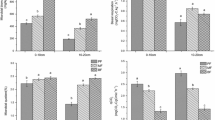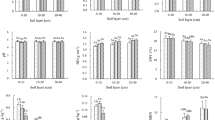Abstract
Conversion of natural secondary broad-leaved forest to Cunninghamia lanceolata plantation is a common management practice in subtropical China. In this study, we compared soil physico-chemical properties, microbial biomass in one natural secondary broad-leaved forest and two C. lanceolata plantation sites to estimate the effects of forest conversion on soil microbial biomass at the Huitong Experimental Station of Forestry Ecology, Chinese Academy of Sciences. Concentrations of soil organic carbon, total nitrogen, NH4 +-N and microbial biomass carbon and nitrogen were much lower under C. lanceolata plantations as compared to natural secondary broad-leaved forest. Soil microbial biomass C in the first and second rotation of C. lanceolata plantations was only 53%, 46% of that in natural secondary broad-leaved forest, and microbial biomass N was 97% and 79%, respectively. The contribution of microbial biomass C to soil organic C was also lower in the plantation sites. However, the contribution of microbial N to total nitrogen and NH4 +-N was greater in the C. lanceolata plantation sites. Therefore, conversion of natural secondary broad-leaved forest to C. lanceolata plantation and continuous planting of C. lanceolata led to the decline in soil microbial biomass and the degradation of forest soil in subtropical China.
Similar content being viewed by others
References
Anderson, T.H., Domsch, K.H. 1986. Carbon link between microbial biomass and soil organic matter [C]. In: Megusar, F., Gantar, M. (Eds.), Proceedings of the Fourth International Symposium on Microbial Ecology. Slovene Society of Microbiology, Ljubljana, pp. 467–471.
Anderson, J.P.E., Domsch, K.H. 1980. Quantities of plant nutrients in the microbial biomass of selected soils [J]. Soil Sci., 130: 211–216.
Basu, S., Pati, D.P., Behera, N. 1992. Microfungal biomass in some tropical forest soils of Orissa, India [J]. For Ecol Manage., 55: 333–339.
Bremer, E., Janzen, H.H., Johnston, A.M. 1994. Sensitivity of total, light fraction, and mineralizable organic matter to management practices in a Lethbridge soil [J]. Can. J. Soil Sci., 74: 131–138.
Bremner, J.M., Mulvaney, C.S. 1982. Nitrogen — total [M]. In: Page, A.L., Miller, R.H., Keeney, D.R. (eds). Method of soil analysis, part 2. Chemical and microbiological properties. American Society of Agronomy, Madison, pp. 595–624.
Brookes, P.C., Landman, A., Pruden, G., et al. 1985a. Chloroform fumigation and release of soil N: a rapid direct extraction method to measure microbial biomass N in soil [J]. Soil Biol Biochem., 17: 837–842.
Brookes, P.C., Kragt, J.F., Powlson, D.S., et al. 1985b. Chloroform fumigation and release of soil nitrogen: the effect of fumigation time and temperature [J]. Soil Biol. Biochem., 17: 831–835.
Chen Chuying, Wang Silong. 2004. Ecology of mixed plantation forest [M]. Science Press, Beijing. pp. 3. (in Chinese)
Chen Chuying, Zhang Jiawu, Zhou Chonglian, et al. 1990. Researches on improving the quality of forest land and the productivity of artificial Cunninghamia lanceolata stands [J]. Journal of Applied Ecology, 1(2): 97–106. (in Chinese)
Chilima, J., Huang, C.Y., Wu, C.F. 2002. Microbial biomass carbon trends in black and red soils under single straw application: Effect of straw placement, mineral N addition and tillage [J]. Pedosphere, 12(1): 5–72.
Devi, N.B., Yadava, P.S. 2006. Seasonal dynamics in soil microbial biomass C, N and P in a mixed-oak forest ecosystem of Manipur, North-east India [J]. Applied Soil Ecology, 31: 220–227.
Dinesh, R., Chaudhuri, S.G., Ganeshamurthy, A.N., et al. 2003. Changes in soil microbial indices and their relationships following deforestation and cultivation in wet tropical forests [J]. Applied Soil Ecology, 24: 17–26.
Ding, Y.X., Chen, J.L. 1995. Effect of continuous plantation of Cunninghamia lanceolata on soil fertility [J]. Pedosphere, 5(1): 57–66.
Gallardo, A., Schlesinger, W.H. 1994. Factors limiting microbial biomass in the mineral soil and forest floor of a warm-temperate forest [J]. Soil Biol Biochem., 26: 1409–1415.
Gregorich, E.G., Carter, M.R., Angers, D.A., et al. 1994. Towards a minimum data set to assess soil organic matter quality in agricultural soils [J]. Can. J. Soil Sci., 74: 367–385.
Han Guiyun, Ge Yinghua, Wang Silong. et al. 2000. Dynamics of soil microbes in the decomposition process of Cunninghamia lanceolata stumps and roots [J]. Chinese Journal of Applied Ecology, 11(supp.): 227–230. (in Chinese)
Hanyes, R.J., Swift, R.S., Stephen, R.C. 1991. Influence of mixed cropping rotation on organic matter content, water stable aggregation and clod porosity in a group of soils [J]. Soil Tillage Research., 19: 77–87.
Huang, Z.Q., Liao, L.P., Wang, S.L., et al. 2000. Allelopathy of phenolics from decomposing stump-roots in replant Cunninghamia lanceolata woodland [J]. Journal of Chemical Ecology, 26(9): 2211–2219.
Huang, Y., Wang, S.L., Feng, Z.W., et al. 2004. Chanes in soil quality to introduction of broad-leaf trees into clear-felled Chinese fir forest in the mid-subtropics of China [J]. Soil Use Manage., 20: 418–425.
Huang, Z.Q., Terry, H., Wang, S.L., et al. 2002. Autotoxicity of Cunninghamia lanceolata on seed germination and seedling growth [J]. Allelopathy Journal, 9(2): 187–193.
Hu Yalin, Wang Silong, Yan Shaokui. et al. 2005. Effects of replacing natural secondary broad-leaved forest with Cunninghamia lanceolata plantation on soil biological activities [J]. Chinese Journal of Applied Ecology, 16(8): 1411–1416. (in Chinese)
Jiang Peikun, Jiang Qiuyi, Dong Lingen. et al. 1995. Comparison of biochemical properties of rhizosphere soil between Cunninghamia lanceolata and Chinese sassafras [J]. Journal of Zhejiang Forestry College, 12(1): 1–5. (in Chinese)
Liao Liping, Gao Hong, Wang Silong. et al. 2000. The effect of nitrogen addition on soil nutrient leaching and the decomposition of Cunninghamia lanceolata leaf litter [J]. Acta Phytoecologica Sinica, 24(1): 34–39. (in Chinese)
Li, Q., Lee A.H., Wollum, I., et al. 2004. Microbial biomass and bacterial functional diversity in forest soils: effects of organic matter removal, compaction, and vegetation control [J]. Soil Biol. Biochem., 36: 571–579.
Martikainen, P.J., Palojarvi, A. 1990. Evaluation of the fumigation extraction method for the determination of microbial C and N in a range of forest soils [J]. Soil Biol. Biochem., 22: 797–802.
Melillo, J.M., Aber, J.D., Muratore, J.F. 1982. Nitrogen and lignin control of hardwood leaf litter decomposition dynamics [J]. Ecology, 63: 621–626.
Salamanca, E.F., Raubuch, M. and Joergensen, R.G. 2006. Microbial reaction of secondary tropical forest soils to the addition of leaf litter [J]. Applied Soil Ecology, 31: 53–61.
Smith, J.L., Paul, E.A. 1990. The significance of soil microbial biomass estimations[C]. In: Bollag, J.M., Stotzky, G. (Eds.), Soil Biochemistry, vol. 6. Marcel Dekker, New York, pp. 357–396.
Sun Qiwu, Yang Chengdong, Jiao Ruzhen. 2003. The changes if properties of the successive Chinese fir plasntation in Dagang Mountain of Jiangxi Province. Scientia Silvae Sinicae, 39(3):1–5.
Vance, E.D., Brookes, P.C., Jenkinson, D.S. 1987. An extraction method for measuring microbial biomass C [J]. Soil Biol. Biochem., 19: 703–707.
Wang, Q.K., Wang, S.L., Deng, S.J. 2005a. Comparative study on active soil organic matter in Chinese fir plantation and native natural secondary forest in subtropical China [J]. Journal of Forestry Research, 16(1): 23–26.
Wang Qingkui, Wang Silong, Gao Hong. et al. 2005b. Dynamics of soil active organic matter in Chinese fir plantations [J]. Chinese Journal of Applied Ecology, 16(7): 1270–1274. (in Chinese)
Wang, Silong, Liao Liping, Deng Shijian. et al. 2000. Mixed of Cunninghamia lanceolata with Michelia and restoration of self-sustaining mechanism in G. lanceolata plantation [J]. Chinese Journal of Applied Ecology, 11(1): 33–36. (in Chinese)
Wardle, D.A. 1992. Comparative assessment of factors which influence microbial biomass Carbon and nitrogen levels in soils [J]. Biological Reviews, 67: 321–358.
Wu, J., Joergensen, R. G., Pommerening, B., et al. 1990. Measurement of soil microbial biomass C by fumigation-extraction: an automated procedure [J]. Soil Biol. Biochem., 22: 1167–1169.
Xu, Q.F., Xu, J.M. 2003. Changes in soil carbon pools induced by substitution of plantation for native forest [J]. Pedosphere, 13(3): 271–278.
Author information
Authors and Affiliations
Additional information
Foundation project: This research was supported by Chinese Academy of Science Program (NO. ZCX3-SW-418) and the Natural Science Foundation of China (NO. 30470303)
Biography: WANG Qing-kui (1977–), male, Ph.D candidate in Institute of Applied Ecology, Chinese Academy of Sciences, Shenyang 110016 P.R. China.
Rights and permissions
About this article
Cite this article
Wang, Qk., Wang, Sl. Microbial biomass in subtropical forest soils: effect of conversion of natural secondary broad-leaved forest to Cunninghamia lanceolata plantation. J. of For. Res. 17, 197–200 (2006). https://doi.org/10.1007/s11676-006-0046-9
Received:
Accepted:
Issue Date:
DOI: https://doi.org/10.1007/s11676-006-0046-9
Keywords
- Soil microbial biomass
- Cunninghamia lanceolata plantation
- Natural secondary broad-leaved forest
- Forest conversion




